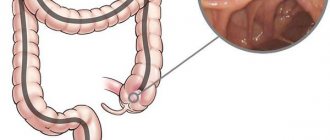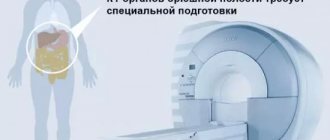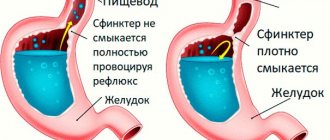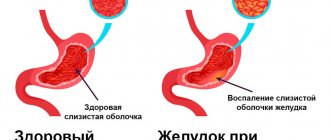- home
- Gastroenterology
- Polypectomy of the stomach and gallbladder
Polyps are a common pathology of the gastrointestinal tract. They are benign neoplasms. If left untreated, they develop into malignant and pose a threat to life. Drug treatment is not effective in the presence of polyps, so surgery is used.
Endoscopic gastric polypectomy is a modern technique that is used at KDS Clinic for the treatment of polyps. During this procedure, soft tissues are not injured, only affected cells are removed. Interference with internal organs is minimized. Polypectomy is considered an outpatient procedure. After it is performed, the patient does not require long rehabilitation, and he can return to his usual lifestyle.
Endoscopic gastric polypectomy is performed in combination with gastroscopy. For surgical intervention, an operating gastroscope and pain relief using medicated sleep (sedation) are used.
Causes of polyps
The appearance of polyps is influenced by several factors. Benign formations in the stomach occur in people with chronic gastritis and duodenal ulcers. Lifestyle also influences the development of pathology. If you have bad habits, including smoking and alcoholism, the risk of the disease increases. Improper nutrition negatively affects the functioning of the gastrointestinal tract and contributes to the appearance of tumors.
Long-term use of antibiotics and other strong medications contributes to the appearance of benign tumors. The cause may also be genetic predisposition.
FAQ
Do I need special preparation for endoscopic removal of gastric polyps?
Polypectomy is performed only on an empty stomach, with the last meal and liquid taken at least 8 hours before the procedure.
How to choose treatment tactics for polyps in the stomach?
Small formations, up to 10 mm, can be removed even during diagnostic gastroscopy. For the hyperplastic type of polyps, which are not prone to malignancy, and whose size is no more than 2 cm, a wait-and-see approach with regular examinations is possible. Polyps of 2-3 cm, as well as several located nearby, are removed using the endoscopic method. Adenomatous polyps, which develop into cancer in 50% of cases, must be removed regardless of size. With large formations, especially on wide bases, there is a risk of bleeding from the polyp bed, so the patient may be recommended surgical polypectomy. Therefore, to choose the optimal treatment method, it is necessary to undergo a comprehensive examination.
Are there any disadvantages of endoscopic surgery to remove a gastric polyp?
The area of the defect in the gastric mucosa that may appear when a polyp is removed depends on the size of its pedicle, as well as the duration of coagulation; The more impressive the base of the polyp, the larger the area of the defect. Therefore, when removing large formations, there is a risk of forming a large area of necrosis; to avoid this, removal of large polyps is possible in parts. It should also be taken into account that insertion of an endoscope during endoscopic polypectomy is difficult if there is an existing deformation of the esophagus or stomach.
Is it possible to do without endoscopic polypectomy?
Today there are no medications that can eliminate formations, but with small hyperplastic polyps and in the absence of complications, a wait-and-see approach is possible. Its essence lies in following a diet, regular examinations (every six months/year), and medications can also be prescribed to reduce the manifestations of the disease (anti-inflammatory, antibacterial, regulating the pH level of the stomach). For polyps larger than 2 cm, as well as in cases where there is a risk of malignancy, their removal is the only treatment option.
What are the dangers of refusing surgery?
Polyps in the stomach of large sizes can impede the passage of food, and in severe cases, cause obstruction. There is also the possibility of internal bleeding, a life-threatening complication. In addition, the morphological shape of the polyp plays a role: if with hyperplastic formations that appear as a result of the proliferation of epithelial cells, the risk of degeneration into cancer is minimal, then for adenomatous polyps developing from glandular cells, especially large ones, the risk of malignancy is 50% or more.
Are there possible complications during endoscopic removal of a gastric polyp and what are they?
Theoretically, there is a risk of bleeding from the bed of the removed polyp or perforation of the stomach wall, however, the use of video endoscopic equipment, the possibility of visual control of the intervention area, as well as the procedure performed by experienced specialists minimizes the likelihood of such complications.
Rehabilitation period after endoscopic removal of a polyp in the stomach
A follow-up examination is carried out after 10-14 days, complete healing of the mucous membrane occurs within 2-8 weeks, during this period it is important to exclude from the menu foods that irritate the stomach. In addition, it is better to divide the daily diet into 5-6 meals. A control gastroscopy is recommended 3 and 6 months after polypectomy; further examinations should be performed annually.
Carrying out the procedure
Before endoscopic polypectomy, the patient undergoes a comprehensive examination of the body, including ultrasound diagnostics. The patient is sent for testing. On the eve of surgery, you should follow a strict diet, give up alcohol and smoking.
Also, before the procedure, blood pressure, pulse, and general health are monitored. Removal of a polyp tumor is carried out under anesthesia using medicated sleep (sedation). A gastroscope is used, which captures the loop with the tumor. The procedure is absolutely painless for the patient and does not require rehabilitation. A few hours after recovery from anesthesia, the patient goes home.
Doctor's comment
Are you indicated for endoscopic removal of gastric polyps, and, as with any intervention, do you experience understandable anxiety? Then you should know that endoscopic polypectomy is the most gentle method that allows you to radically get rid of the disease. The absence of incisions on the skin, safety, short duration of the procedure itself, after which you can immediately return to your normal lifestyle - these are the main advantages of this technique. Moreover, the use of modern drugs makes it possible to completely eliminate unpleasant sensations, so endoscopic polypectomy is an operation that is easily tolerated by patients of any age. Of course, this intervention is prescribed only after an examination, which can be completed in our clinic. If you are worried about stomach problems or polyps have already been discovered during the examination, in any case, do not delay treatment, because timely consultation with a doctor makes it possible to get rid of the disease in the most minimally traumatic and painless way!
Head of the surgical service at SwissClinic Konstantin Viktorovich Puchkov
Preparation for the procedure
Before the procedure, the patient should quit smoking. It is advisable to take plenty of drinking water. It is important to follow a strict diet, eliminating fatty and floury foods. It is also advised to exclude foods that contain fiber. This substance affects the volume of the large intestine.
To cleanse the intestines, the patient is given an enema or prescribed laxative medications. A complete examination of the gastrointestinal tract will be required. The patient undergoes endoscopic examination and ultrasound diagnostics. You need to take a blood clotting test and determine your Rh factor.
Immediately before the procedure, the patient’s blood pressure is measured and the pulse is checked. The doctor should be interested in the patient's condition.
How is the operation performed?
One of the important factors determining the tactics of polypectomy is the size of the tumor:
- Polyps up to 0.5 cm. In this case, removal of the tumor can be carried out at the stage of diagnostic examination - fibrogastroscopy or colonoscopy.
- Polyps larger than 0.5 cm. The operation begins only after additional examination methods have been carried out, excluding the presence of contraindications. After polypectomy, provided that a tumor up to 3 cm in size is removed, the stay in the clinic ranges from several hours to 2-3 days. Active monitoring of the patient continues as long as the patient’s general condition requires.
At the end of the procedure, the removed material is always subjected to histological examination.
Symptoms of polyp formation
Content
- Symptoms of polyp formation
- Is surgery necessary?
- Treatment tactics
- Postoperative complications
- Rehabilitation
The early stages of polyp development are completely asymptomatic. If the neoplasms provoke gastritis or other gastrointestinal diseases, then a number of classic signs are observed, which mainly appear immediately after eating or after an hour or two: broken stools; flatulence and belching; vomiting and nausea; increased salivation; decreased appetite; dull and aching pain in the abdomen; feeling of fullness in the stomach; heaviness in the stomach area.
If you do not pay attention to the symptoms in the early stages, in the future it will be accompanied by pain in the lower back or shoulder blades, general weakness, and fever. Larger polyps can cause bleeding, which will lead to severe vomiting of blood. After the polyps grow into the duodenum, cramping pain in the abdominal area and under the breasts may occur.
Reviews of doctors providing the service - Endoscopic polypectomy of the intestine and stomach
I had a gastroscopy at your center and was very worried about how everything would go, but it turned out that everything went quickly and painlessly.
I cannot describe in words how grateful I am to Vladislav Mikhailovich Danyushin. For his golden hands, professionalism, kindness of heart! Wonderful doctor! Low to you... Read full review Tatyana K
28.07.2021
On 02/01/2021 I was examined at the diagnostic and treatment department of CELT JSC. I would like to express my gratitude to the head of the department, Alexandra Ivanovna Malykhina, for her attentive and informal attitude towards me, as well as for the effective organization of work to clarify my diagnosis and prescription... Read full review
Alexander Sh
02.02.2021
Types of stomach polyps:
- Adenomatous polyp of the stomach is a benign tumor, which is a proliferation of glandular tissue.
- A hyperplastic gastric polyp is a growth of epithelium that is not considered a benign tumor. This type is much more common (approximately 16 times) and has a more favorable prognosis. It never develops into cancer, unlike adenomatous polyps.
- A hyperplasiogenic polyp of the stomach is formed when the regeneration of the glands of the gastric mucosa is impaired.
- The predominant localization of hyperplasiogenic polyps is the body of the stomach.
GASTROCENTER
ATTENTION! GASTROCENTER - SPECIALIZED CLINIC FOR PROFESSIONAL ENDOSCOPY AND CLINICAL GASTROENTROLOGY) HAS ADDRESSES: MOSCOW, ACADEMIKA BOCHVARA STREET, 15, this is a new modern clinical center based on CEMS, Center for Endodiagnostics and Minimally Invasive Surgery, website address https://cemx. ru/gastrocentr/
and MOSCOW, BERZARINA STREET, 12 (clinic under reconstruction, old website address WWW.GASTROCENTER.PRO) THERE ARE NO OTHER BRANCHES! For epidemiological safety, no more than 4-6 patients are in the clinic at a time, personal protective equipment is used, air and surfaces are constantly disinfected, and strict epidemiological regulations are observed!
CONTACTS Photo gallery
MOLAKA EKATERINA YURIEVNA endoscopist, gastroenterologist-hepatologist, candidate of medical sciences, head. Department of Endoscopy and Gastroenterology (work experience since 1994) see full resume
KUZNETSOV KONSTANTIN VALERIEVICH Endoscopist-surgeon, gastroenterologist, head. Department of Endosurgery, member of the European Association of Gastrointestinal Endoscopy (work experience since 1995) see full resume
KHARNAS SERGEY SAULOVICH oncologist, surgeon, professor, doctor of medical sciences, head of the consultative department of surgery and oncology, work experience 37 years, see full resume
FOR MORE DETAILS ABOUT NO-INCISION SURGERY, SEE THE BLOCK AT THE BOTTOM OF THE PAGE
We examine and treat patients with:
- diseases of the esophagus GERD, reflux disease, esophagitis, Barrett's esophagus, achalasia cardia and cardiospasm, etc.
- diseases of the stomach and duodenum: peptic ulcer, erosive lesions of the stomach and duodenum, all types of gastritis, etc.
- intestinal diseases: IBS - irritable bowel syndrome, intestinal polyps, diarrhea and constipation, ulcerative colitis and Crohn's disease, celiac disease, SIBO - bacterial overgrowth syndrome in the colon, dysbiosis, etc.
- liver diseases, fatty liver disease (steatosis, fatty hepatosis), we verify hepatitis of viral, toxic and autoimmune origin
- diseases of the pancreas - pancreatitis,
- benign and malignant tumors (see here)
- diseases of the gallbladder - biliary dyskinesia, polyposis of the gallbladder, cholelithiasis (GSD)
- We conduct full CHEK UP screening examinations to identify early tumors of the gastrointestinal tract and other localizations (in our center, in one day you can undergo gastroscopy and colonoscopy in one sleep, performed by expert doctors with European practice, followed by consultation with a gastroenterologist k.m. .n.)
Advantages of GASTROCENTER
o RULE OUT TUMORS: AT THE GASTROCENTER you can undergo a complete examination (Check-up) of the gastrointestinal tract in one day, painlessly and inexpensively, to exclude the development of tumors, which rank first in prevalence in the world and in Russia. o IN YOUR SLEEP: do research - gastroscopy, colonoscopy, bronchoscopy - in your sleep, which improves the quality of the examination and makes it comfortable and safe. o ALL TESTS AT ONCE: during the study we perform all tests - Helicobacter Pylori (ready in 3 minutes), histology, etc. o HIGH-PRECISION EQUIPMENT: do research on EVIS EXERA II (Japan) - ultra-precise modern equipment: with the possibility of optical and electronic zoom., NBI, HDTV. o EXPERT CLASS DOCTORS: our doctors, Ph.D., have over 20 years of experience in the largest Russian medical institutions, experience in Europe and training in Japan to identify and remove through a flexible endoscope the smallest tumors invisible in a conventional endoscope. In addition, our specialists treat patients, being at the same time gastroenterologists, hepatologists and nutritionists (European standard of gastroenterologist). o GET HELP OF A GASTROENTEROLOGIST IMMEDIATELY: AT THE GASTROCENTER you will be consulted by a doctor, candidate of medical sciences, gastoenterologist, immediately after the examination. o DO GASTROSCOPY, COLONOSCOPY, VIDEO CAPSULE ENDOSCOPY, BRONCHOSCOPY IN YOUR SLEEP IMMEDIATELY IN ONE DAY: AT THE GASTROCENTER you can do all types of endoscopic examinations and/or several examinations at once in one day: and immediately from the same specialist get advice on drug treatment and necessary further examination of your diseases. o IMMEDIATELY REMOVE POLYPS AND CARRY OUT ENDOSCOPIC OPERATIONS IN YOUR SLEEP AND WITHOUT HOSPITALIZATION simultaneously during gastroscopy or colonoscopy, bronchoscopy: in the Gastrocenter all types (see price list, list of operations) of endoscopic operations are performed through a flexible endoscope (“surgery without an incision”) by expert class specialists . o TAKE ALL TESTS IMMEDIATELY: IN THE GASTROCENTER all types of laboratory tests and ultrasound are performed. You can undergo a complete examination of the gastrointestinal tract in one day, and for smokers, check the condition of the tracheobronchial tree and lungs.
DISCOUNTS AND CONVENIENT PROMOTIONS: GASTROCENTER cooperates with major medical institutions in Russia in the field of studying Helicobacter pylori, GASTROCENTER widely practices promotions and discount programs.
PHOTO GALLERY SPECIALISTS PRICE LIST
digital gastroscopy digital colonoscopy
- What operations on the gastrointestinal tract can be performed through a flexible endoscope without an incision?
- Who performs such operations?
- How to prepare for such operations?
Endoscopic removal of an early tumor in the stomach, endoscopic resection
What operations on the gastrointestinal tract can be performed through a flexible endoscope without an incision?
Removal of benign tumors in the larynx, pharynx, esophagus, stomach, duodenum, colon.
Most neoplasms that are benign in nature and located in the lumen of the gastrointestinal tract can be removed without an incision, i.e. through an endoscope.
This type of operation includes polypectomy (removal of polyps) of the esophagus, stomach and duodenum, colon, bronchi, larynx, papillomas of the mucous membranes of the trachea, esophagus, larynx, removal of foci of hyperplastic laryngitis, “singer’s nodules”. To carry out such operations, various approaches and types of endoscopic operations are used, as well as special instruments that can be inserted into the instrumental channel of the endoscope.
All these types of operations are high-tech and require significant experience of the performer (see specialists), most of them are performed directly during planned endoscopic procedures, i.e. during gastroscopy, colonoscopy, bronchoscopy, laryngoscopy. The patient does not experience any discomfort, because... is in a state of sleep (sedation, see anesthesia).
Dilatation (widening) of the narrowing of the esophagus
Colon polyp.
Polypectomy of colon polyp
Here are the results of some interventions carried out by specialists at our center.
Removal of malignant neoplasms of hollow organs
These operations through a flexible endoscope have their limitations and clear indications. They are most often performed for the purpose of a total (i.e. complete) biopsy in order to send for histological examination the entire fragment of the mucous membrane or the entire tumor suspicious for malignancy.
A significant achievement, a breakthrough in medicine, is the ability to remove early cancer (that is, cancer within the mucous membrane of an organ) through a flexible endoscope. This type of operation is called endoscopic resection and/or mucosal dissection, i.e. We are also talking about “surgery without an incision,” when surgery is performed through the natural openings of the human body.
The undisputed undisputed leader worldwide in the detection of stomach cancer and the effectiveness of its treatment, primarily using operations through a flexible endoscope, is Japan. The incidence of stomach cancer in Japan is due to a combination of many factors, the most important of which are genetic predisposition, Helicobacter pylori, and consumption of large amounts of salt in the diet. Japanese endoscopic technology and endoscopy in Japan are steadily improving and provide us with the opportunity to perform such operations with the help of Japanese technologies.
Who performs such operations?
Specialists of our center Kuznetsov Konstantin Valerievich, Patoka Ekaterina Yuryevna, Knyazev Mikhail Viktorovich, Zalesova Victoria Gennadievna perform such and more complex endosurgical interventions, each of these specialists has experience and internships in Europe, Japan, in particular Kuznetsov Konstantin Valerievich and Patoka Ekaterina Yuryevna interned in 2006 at the Niigata University Hospital (Honshu Island, Japan) to improve the level of endoscopic diagnosis and endoscopic operations (see certificates), where they were trained not only to identify almost imperceptible early forms of malignant neoplasms of the esophagus, stomach and colon, but also to operate their.
Below you can familiarize yourself with the resection of the gastric mucosa performed by Dr. Patoka Ekaterina Yuryevna and the resection of the colon mucosa performed by Dr. Kuznetsov Konstantin Valerievich.
In addition to the removal of tumors using a flexible endoscope, other therapeutic endoscopic operations exist and are used in our center, for example for:
- Angiodysplasia of the mucous membranes, vascular pathological growths, which can cause bleeding from the upper and lower parts of the gastrointestinal tract and respiratory tract.
As a rule, they are performed by electrocautery, argon plasma coagulation (“welding”) or endoscopic clipping.
- Balloon dilatation, bougienage - expansion of the narrowing of the lumen of the organ using special instruments
- Removal of a foreign body from the lumen of the gastrointestinal tract
- Stopping bleeding in erosive-ulcerative and other diseases of the esophagus, stomach, duodenum and colon
- Installation of an intragastric balloon (see endoscopic correction of excess weight)
How to prepare for such operations?
Preparation for endoscopic operations that are performed during gastroscopy, colonoscopy, bronchoscopy, laryngoscopy is the same as usual for these procedures. Only a small number of these interventions require additional training.
If you need to conduct an endoscopic examination or treatment, if you want to be sure that you are healthy and do not have any serious diseases, it is more reasonable to carry out the examination on high-precision equipment, in a state of comfortable sleep and with the help of certified, highly experienced, competent specialists in this field. We are ready to provide all this to you at the Gastrocenter: a center for professional treatment and diagnostics of the digestive organs.
WE WORK 7 DAYS A WEEK. PARKING IS FREE.
SEE Preparation for gastroscopy SEE Preparation for colonoscopy, for gastroscopy and colonoscopy at the same time SEE Preparation for bronchoscopy SEE Preparation for installation of an intragastric balloon SEE Preparation for removal of an intragastric balloon
Prevent the development of tumors in yourself - get checked now Chech-up, screening, prevention
Ask a question, leave a review
News and useful information
- Gastroenterologist + endoscopist = accurate diagnosis and correct treatment
- Sedation – your gastroscopy and/or colonoscopy with pleasure
- It has been proven: no polyps - no cancer. Get checked now
- Colonoscopy and polyp removal in one go
Section <<how to…>>
- How should your endoscopic examination be performed correctly?
- How should the endoscope and instruments be handled correctly?
- How should your research be documented?
- How to choose the right clinic for endoscopy
Rehabilitation
Be sure to see a doctor after 2 weeks for a follow-up examination. After abdominal surgery, control diagnostics are prescribed after 30 days. It is important after the procedure to adhere to a diet without fatty, spicy, bitter, sour and heavy foods for at least 12 months (table No. 1). After abdominal surgery, you should not lift heavy objects; it is recommended not to make sudden movements or overstrain the abdominal area for a month.
More fresh and relevant information about health on our Telegram channel. Subscribe: https://t.me/foodandhealthru
We will be grateful if you use the buttons:











